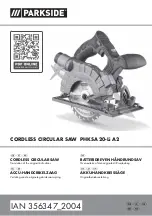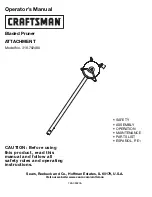
INCRA
IBOX
OWNER’S MANUAL
Manufactured by Taylor Design Group, Inc. P.O. Box 810262 Dallas, TX 75381
W W W . I N C R A . C O M
Page 4
3. Attach IBOX to GlideLOCK™ Miter Bar
Assembly
Position the IBOX fence on the GlideLOCK™ Miter
Bar Assembly with the red knob on the left end for left
tilting saws or on the right end for right tilting saws.
Insert the (2) #10-24 x 3/8” button head fasteners
through the slotted holes in the fence and thread
into the holes on the GlideLOCK™ Miter Bar. Don’t
tighten the fasteners just yet. With your table saw
unplugged, raise the dado up about 1/2” then slide
the IBOX so that the cutter is inside the tall notch
in the fence. Carefully slide the IBOX to the left or
right until the blade “kisses” the steel pin plates on
the IBOX, Fig. 4 and Detail 4A. Make sure that
the IBOX is firmly in contact with the alignment plate
on the GlideLOCK™ assembly then tighten the (2)
button head fasteners to secure the fence to the bar.
Lower the blade. NOTE: If you later move the
IBOX to another table saw or your router
table, you will need to reset the miter bar’s
position as described in steps 1-3 above for
the table saw or as described in steps 1-2
on page 4 for the router table.
Continue by skipping ahead to the section
titled “STOCK LEDGES, BLADE GUARDS
AND BACKING BOARD” on page 5.
Fig. 4
Attach IBOX to Miter Bar
Alignment plate
2) Secure IBOX against
alignment plate and
tighten both fasteners
1) Slide IBOX to
contact blade with
pin plates
Pin plates
Detail 4A
Blade should
just touch pin
plates
Fig. 5
Adjust Miter Bar
3/32” hex key
Alignment
plate
Adjust GlideLOCK™
mechanisms for smooth glide
SETTING UP AT THE ROUTER TABLE
1. Adjust GlideLOCK™ Miter Bar
Assembly
Drop the GlideLOCK™ Miter Bar Assembly
into your router table’s miter slot. Now adjust
the GlideLOCK™ expansion discs at each
end of the bar to adjust the fit for a smooth
glide in your router table’s miter slot. Turn the
fasteners clockwise to make the glide tighter
or counterclockwise for a looser glide, Fig. 5.
The alignment plate is factory squared but can
be re-adjusted as required by loosening the (2)
button head fasteners.






























